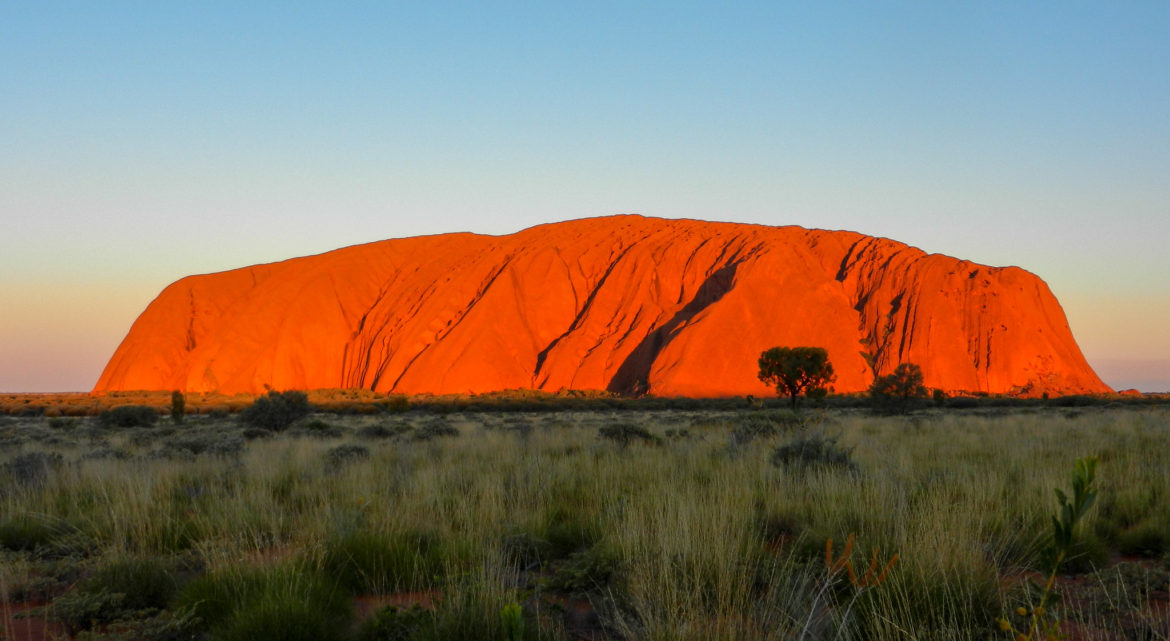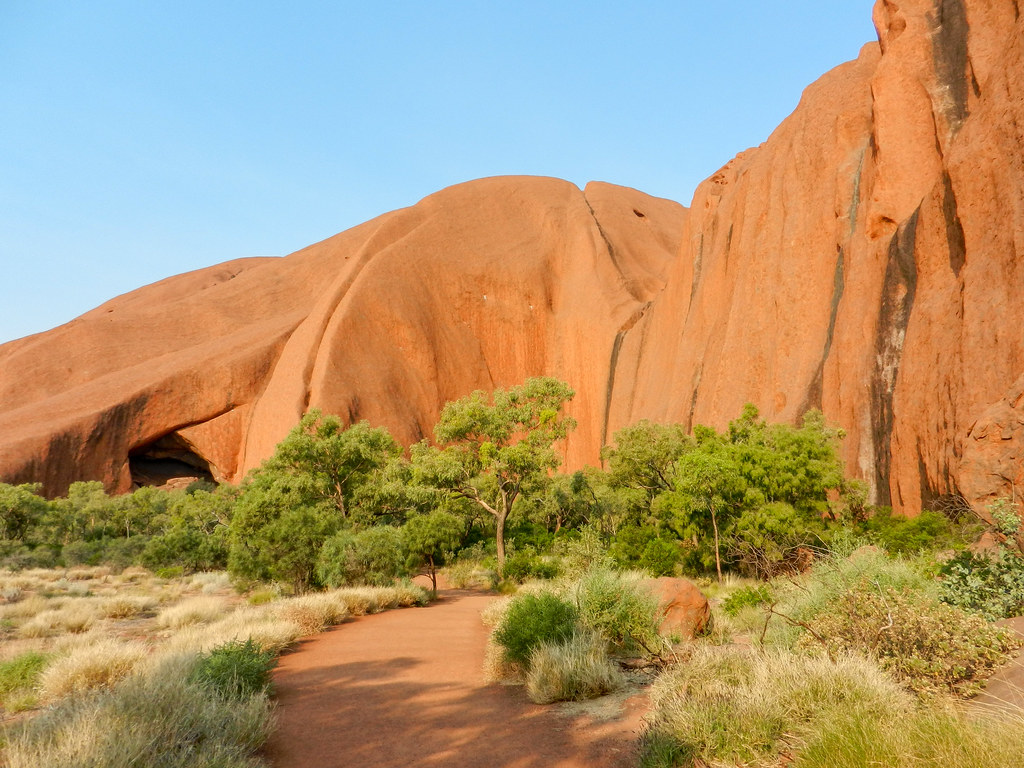Australia’s Uluru attractions are a must-see for anyone visiting the Outback. It was considered sacred for thousands of years by the Anangu, Aboriginal people in Australia’s Red Centre. I wanted to tap into the roots of this ancient site and discover its essence, beyond the exploited postcard image known as “Ayer’s Rock.” At Uluru, the geological and mystical dimensions are infinite, with many ways to explore this iconic landmark.
To allow myself time to see Australia’s Uluru attractions, I reserved 4 nights and 3 days at a hostel in Yulara. This is a community for visitors at Uluru-Kata Tjuta National Park. After a 6-hour bus ride from Alice Springs, I quickly settle. Then, I take the shuttle to spend the afternoon and sunset at Uluru. To see Uluru for the first time is one of those experiences that you never forget. It truly is surreal, feeling as though simply through Uluru’s presence, you are transported to a mysterious time and place. I could feel its ancient roots ground me into a deep dimension, connected with ancestors and lost myths from the universal mind.
This landmark is an inselberg or “Island mountain”
This monolithic landmark stands alone as an inselberg, literally an “island mountain” as a vestige of an eroded mountain range. Its solitary, megalithic presence is almost intrusive on your senses! It stands at 345 m high, with a circumference of 9.4 km. Secretly, it is a part of an underground mountain range, submerged 5 – 6 km below the earth. This includes the nearby Kata Tjuta and Mt. Connor. The sandstone and feldspar, with iron-bearing minerals, oxidize to create the looming red presence. Uluru’s unique geological feature is its homogeneity of the rock and lack of jointing, leading to minimal development of scree. This feature is what lead to its longevity and survival, while the surrounding rocks eroded away.
Australia’s Uluru Attractions / Sunset Walk with Anangu People
On my second day, I took a morning and an afternoon/sunset walk with Anangu people, planned through an Aboriginal organization. I wanted to connect with the Aboriginal dreamtime stories of Uluru and learn more about this ancient, rich culture in their indigenous environment. After watching the sunrise over Uluru, I went on a morning Liru Walk. This was lead by an Aboriginal man with an interpreter from the Cultural Centre to the base of Uluru.
He demonstrated how to make spears and the coolamon from tree trunks (carrier balanced on top of head by women). There was an eclectic array of flowers along the way sprinkled on the red dirt. This year the Red Centre received the most rain in 50 years. So the mulga tree groves were brightened with flora, such as, lavender, honey grevillea, desert red pea and pink everlastings.
Australia’s Uluru Attractions – Kuniya Walk
In the late afternoon and evening, I went on the Kuniya Walk lead by an Aboriginal woman to explore the terrain for bush food and medicine; plus, learn a Dreamtime Creation Story. I discovered my favorite sanctuary of Uluru at Mutijulu waterhole, where there cross-pollinates a plethora of inspirational sites. Immediately, I felt a serenity and silence so empowering, that my mind acquiesced to being quiet in deep contemplation.
Aboriginal Myth about the Dreamtime Creation Story
The Aboriginal Guide told the Dreamtime story about the Battle of Liru. A venomous snake and Kuniya, a young woman python. Long, long ago during the Creation or Dreamtime Period (Tjukurpa) the Kuniya was ambushed by the Liru (poisonous snakes) and killed by spears. The spears that missed made holes in the Uluru rock, that are still there. Kuniya’s aunt was so upset that she killed one of the Liru with a blow to the head. The blood flowing from the head of the dead Liru can still be seen.
This is just one of many Aboriginal creation or Dreamtime stories about Uluru. These explain the unique, physical features of this natural monument. Interestingly, while observing the landscape of this story, we discovered a large monitor lizard camouflaged alongside the canyon wall. He remained there as a silent messenger of stillness for us all to observe.
Bush Food & Medicine with Coolamon
The Aboriginal woman and interpreter picked samples of bush food and medicine, collecting them in the coolamon. We observed the ochre paintings on the canyon walls. I learned that concentric circles indicate a waterhole and the yellow flower, the honey grevillea. By the end of the walk, the coolamon had grown into a colourful cornucopia of bush food. We sampled the desert peaches and figs that were very tasty. However, they are smaller and less sweet than the ones from the U.S.
The desert inspires the natural kingdom to be creative and resourceful with food, based on survival needs. Gluttony just doesn’t belong in this environment. We ended the day with my second sunset viewing at Uluru. It was even more muted than the night before, due to the bush fire haze. I started to admit my disappointment in the gray skies from the haze, and accept that I may miss out on the luminescent, red reflections that Uluru is known for at sunset.
Australia’s Uluru Attractions – Helicopter Ride
The next day was a whirlwind starting off with a helicopter ride over Uluru, accentuating even more the disproportionate inselberg of Uluru and Kata Tjuta from a seemingly flat, endless spinifex landscape.
In the afternoon, I went on a walk to Walpa (meaning “windy”) Gorge at Kata Tjuta. From the same underground mountain range as Uluru, Kata Tjuta aka the “Olga’s” or “many heads.” This name is due to its dome-like sandstone formations. In my walk we followed a path along a peaceful stream through the gorge between 2 sandstone domes to a grove of spearwood trees. The unique ecosystem at this area grows plants that exist nowhere else in the world. I don’t mean to undermine the magnificence of Kata Tjuta because it is as spectacular as Uluru in its own unique way. However, I just didn’t spend enough time there to connect with it. (Photo below)
Finally, on my third sunset viewing, I joyously see the renowned sunset, illuminating Uluru’s primary red spectrum of light. (see first photo) The winds had shifted, blowing the bush fire smoke away, leaving clear skies for a bright sunset. This made it possible for Uluru to reflect its bright neon red lights, about 10 minutes before the sun sinks below the horizon. These fleeting moments are a portal in time, opening a glimpse into eternity, when the sunset ignites Uluru into electric rays of Red Dreamtime. This perfect storm of circumstances synergistically creates a visual effect so stunning and bright, that you observe in disbelief. Such beauty seems only possible in supernatural realms. However, my pictures are a testament to how real the beauty of Uluru truly is at sunset.
Red Dreamtime Walkabout
The culmination and highlight of all my experiences at Uluru was my 3-hour, 10 km Walkabout around the base of Uluru on my last day. To explain it in a linear way is incongruent, so I conclude with my Red Dreamtime Journal excerpt:
My Walkabout’s Stream-of-Consciousness
The walkabout unfolds naturally into a vision quest, as the meditative surroundings deeply pull me into a rhythm that flows freely with nature…I feel the Songlines sing through me, out into the harmony of oneness… each step is a breath in and out, connecting me deeper and deeper to a surrendered movement and path… invisible vortices subtly tug at my magnetic field, expanding my awareness…the ancestral shadows are keenly present, empowering me to excavate the deepest wellspring of being. Roots ground eternity into one solid resonance, opening a portal to wander in time-space… the mystical landscapes drum into my marrow, calling me to let the ego go…
Creative forces dance amongst the rocks, colours and light with the past, present and future as now. I realize the eternity of a moment, when so deep in it.
The lithospheres resound our infinite dimensions and layers of consciousness, from which to manifest. Animals, birds, flowers, rocks, springs and trees have spirits animating into one web of being. Everything is everything. Nature is the force that integrates wholeness. Bush medicine grows from the ground, offering gifts of the earth’s essence. Intuitive senses perceive every vision, smell, sound and feeling as an omen of truth. Visceral spirits disintegrate boundaries into a beautiful abyss. The wild beauty bathes the skin with overtures, sung by the winds, where the sky and earth become heralds of wisdom. Listen to the songlines and sing yourself into co-existence. The red rock formations are chimerical creatures of creation stories. Walking a circle around Uluru connects beginning to end, like our cycle of life from which all endures, eternally…Aboriginal visions open the mindstream into eternal realm of Red Dreamtime. Palya…
Read Next!
Awesome Outback Attractions near Alice Spring, Australia
Perth, Australia’s Top 10 Attractions – The World’s Most Remote City












